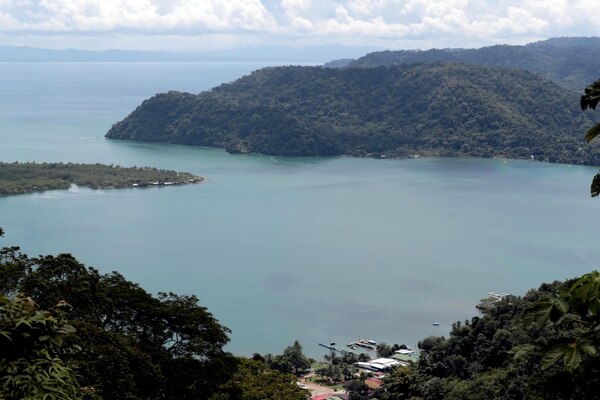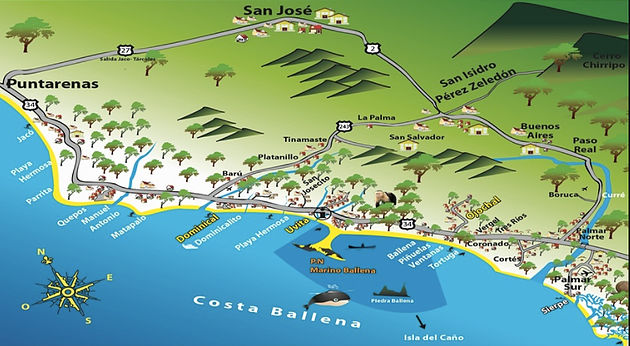
I recently published a post on the allure of the Costa Rica southern zone, which was tightly focused on the city of San Isidro in Perez Zeledon and the Costa Ballena beaches of Dominical, Uvita and Ojochal.
However, the southern zone is much bigger than that! So, how about the rest of it?
Well, the rest of it is pretty special too. Therefore, I decided to write another post – the allure of the Costa Rica southern zone – part 2.
Below are a few locales that are worth a look, in random order…
Golfito
This historic port town is located on the Golfo Dulce, not too far from the Panama border. It was until the mid 80’s headquarters of the infamous United Fruit Company. The banana plantations that once surrounded this area and kept the port humming have been replaced with African Palms. Nevertheless, Golfito retains an historic appeal with many of the homes and commercial buildings well-preserved from that bygone era. It is also a very beautiful and serene setting with sweeping views of the tranquil Golfo Dulce.
It is also the home of a major “free trade zone” that lures ticos and expats in to take advantage of “tariff-free” pricing. To do that you have to stay one night in the town, which can make for an adventurous and money-saving mini-vacation.
Puerto Jimenez
The two major tourist “gateways” to the famed Corcovado National Park are Puerto Jimenez and Drake Bay. Corcovado is one of the largest national parks in Costa Rica and the one that National Geographic once dubbed, the most biodiverse area on earth. Puerto Jimenez is the last outpost before reaching Carate Station, which is the southern-most ranger station in the park. It is also near famed jungle lodges, such as the Lapas Rios and La Leona Ecolodges. Puerto Jimenez is also situated on the Golfo Dulce and is a quaint little touristy town that can be a fun place to pass a night before trekking into the park.
Drake Bay
This is where you go to visit the northern end of Corcovado park. Drake Bay is a little harder to reach than its rival outpost, Puerto Jimenez. Most tourists will either fly in, or leave their car at the river town of Sierpe and then take a boat down the river, out into the Pacific, and then around the rocky coast to Drake Bay. Drake Bay is home to some really nice ecolodges, such as Aguila de Osa and Copa de Arbol.
It is also only a short boat ride to Caños Island, which with its coral reef, is one of Costa Rica’s top diving destinations. It is a fairly short boat ride from Drake to the very heart of the Corcovado park, the famed Sirena Ranger Station, which is an unforgettable experience as you will get up close and personal with some of Costa Rica’s most exotic wildlife.
San Vito
San Vito is a small inland pueblo in the canton of Coto Brus. It is very close to the Panama border. There is an official border crossing only about 30 minutes away at Rio Sereno. San Vito is a beautiful area of green rolling hills and is very unique in that it was founded by Italians. You can get great authentic Italian food there. My favorite is Pizzaria Liliana, which probably has the best pizza in Costa Rica.
The La Casona indigenous reserve of the Ngäbe-Buglé, or Guaymi, peoples is also close by. This is an indigenous group that is centered in northern Panama and southern Costa Rica and has a bright and colorful culture.
Boruca Indigenous Reserve
One of my favorite places to visit is the Boruca Indigenous reserve located in the fila brunqueña coastal mountain range, not far from Palmar Norte, where the Costanera and Pan American highways meet. The Boruca people are well-known for their arts and crafts, especially carved and painted masks. The masks are often of a devilish design stemming from their traditional festival called the Danza de los Diablitos, or dance of the little devils. The festival is in December of each year and is a surreal re-enactment of the struggle between the indigenous people and the Spanish conquistadors. The Borucans are also famous for their cloth items, all of which are made on traditional looms with naturally produced colors.
I used to operate a store in San Jose that sold indigenous arts and crafts. Here’s a short home-made video from that era on the Boruca reserve…
Mountain Pueblos of Perez Zeledon
These pueblos are too many to name in this short post, but the entire canton is dotted with them. They can be great places to visit and even live. In fact, I actually do live in one one of them, Quebradas. It is on a gorgeous mountain river, at an altitude that delivers a near-perfect climate, and is only minutes from the city of San Isidro. I believe it might be the best place on earth…I know, my bias is showing. In my real estate practice I get to discover new pueblos all the time and even though I’ve been at it quite a few years now, I know there are many as of yet undiscovered.
I must also give a shout-out to the in-between-area (IBA) pueblos of Tinamastes and Platanillo. These are in the area that’s between San Isidro and Playa Dominical in the coastal mountain range. They are drop-dead gorgeous little towns and you can live in them at high altitudes and if you’re lucky, even have an ocean view. This area is also home to three incredible waterfalls, Nauyaca, Diamante and Eco Chontales.
I know I’m leaving out some of the gems that help give rise to the allure of the Costa Rica southern zone. Please leave comments on anything I might have missed.
I hope my posts are painting a compelling picture for you of how special the Costa Rica southern zone is.
